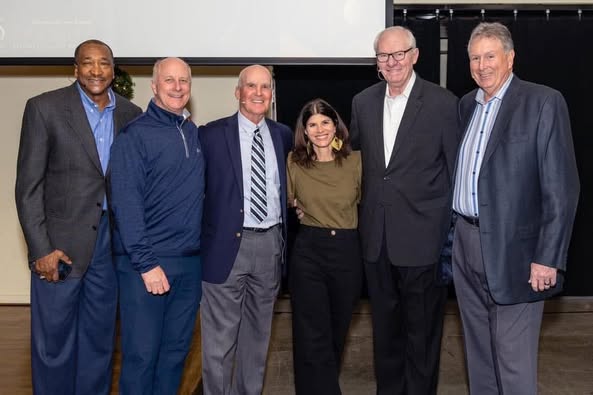Georgia Football Overreactions: Tight End Elyiss Williams Emerges as a Towering Force, While Running Back’s Absence Raises Concerns
As the Georgia Bulldogs progress through their fall camp and inch closer to the start of the 2025 college football season, a pair of storylines have already begun to capture the attention of fans, analysts, and coaches alike. On one hand, tight end Elyiss Williams has emerged as a towering presence on the practice field, showing signs of becoming a major weapon in Georgia’s offense. On the other hand, the absence of a key running back from early camp sessions has sparked concern and speculation about depth and readiness in the Bulldogs’ backfield. These contrasting developments encapsulate the unpredictability and drama that define college football’s preseason, underscoring how quickly narratives can shift and expectations rise or fall in the blink of an eye.
Elyiss Williams, a 6-foot-7, 245-pound athlete, has long been regarded as a raw but promising talent since he arrived in Athens. His size alone makes him an imposing figure, but it is his combination of athleticism, hands, and football IQ that has begun to distinguish him during this fall camp. Coaches and teammates alike have remarked on his rapid progression in grasping the complex offensive schemes and his growing confidence as a pass-catcher and blocker. In drills and scrimmages, Williams has repeatedly made plays that remind observers of some of Georgia’s past great tight ends, players who have gone on to NFL careers and helped the Bulldogs win championships.
The excitement surrounding Williams is rooted not just in his physical attributes but in his work ethic and coachability. According to insiders within the program, Williams has approached camp with a level of dedication that sets him apart from many newcomers. He has been meticulous in studying film, attentive in meetings, and relentless in practice drills. The coaching staff, led by offensive coordinator Mike Bobo, has praised his ability to quickly assimilate feedback and adjust his technique. This adaptability is crucial, especially for tight ends, who must balance responsibilities in the passing game and the run game, often serving as the team’s Swiss Army knife on offense.
Williams’ emergence is particularly significant given the evolving nature of Georgia’s offense. Head coach Kirby Smart’s philosophy has long emphasized a balanced attack, blending power running with a dynamic aerial assault. Tight ends at Georgia have traditionally been pivotal in this approach—serving not only as blockers who can open running lanes but also as reliable receiving options capable of exploiting mismatches against linebackers and safeties. Williams’ size and skills give the Bulldogs the potential to create new challenges for opposing defenses, who will have to account for his ability to stretch the field and dominate contested catches.
The impact of Williams’ rise is already being felt among the team’s offensive personnel. Quarterback Gunner Stockton, entering his third season as a starter, has expressed confidence in the tight end’s ability to be a trusted target in critical situations. “Elyiss is a guy who’s grown so much,” Stockton said during a recent media session. “He’s big, physical, and has great hands. When he’s on the field, I feel like we have an extra weapon that defenses have to respect. That opens things up for the rest of us.” This endorsement from a leader in the locker room signals the growing trust Williams has earned and the potential for him to play a breakout role in the 2025 season.
Yet as Williams’ stock rises, a contrasting story unfolds in the running back room. A key back, who had been expected to contribute significantly, was notably absent from the early days of fall camp. This absence has raised eyebrows given the importance of the running game in Georgia’s offensive identity and the depth concerns created by departures to the NFL and transfers in recent years. Running backs coach Dell McGee has maintained a positive tone in media interviews, emphasizing that the team is prepared to handle the situation and that other backs have stepped up impressively in practice. Nevertheless, the absence of a primary back during camp leaves unanswered questions about the backfield’s overall health and readiness.
Running backs at Georgia have long been a vital component of the Bulldogs’ success, providing the power and explosiveness needed to complement a strong defense. Players like Zamir White and James Cook have left lasting legacies in recent years, setting high expectations for their successors. This year’s crop of backs, while talented, faces the challenge of filling big shoes and maintaining the program’s tradition of physical, downhill running. The missing back was expected to be part of a committee approach, contributing both as a runner and a receiver out of the backfield. His absence shifts some of that load onto other backs, creating opportunities for younger players to showcase their talents but also increasing the risk of overuse or fatigue.
The cause of the running back’s absence has not been officially disclosed by the team, fueling speculation among fans and media. Some insiders suggest it could be related to a minor injury sustained during offseason training, while others wonder if eligibility or personal issues might be factors. In an era where transfer portals and NIL agreements have changed the landscape of college football, such absences can sometimes hint at deeper complexities within a program. However, the coaching staff remains tight-lipped, choosing to focus on what they can control—preparing the team with the players available and keeping morale high.
This juxtaposition of Williams’ rise and the running back’s absence highlights a fundamental truth about football—rosters are dynamic, and preseason can be unpredictable. Injuries, personal matters, and development curves can all alter expectations rapidly. For Georgia, a program accustomed to excellence and detailed preparation, the ability to adapt is key. The coaching staff’s response to these developments will be telling, as they must balance nurturing Williams’ growth while managing the uncertainties in the backfield.
The Bulldogs’ offense, under Smart and Bobo, prides itself on versatility and execution. It is a system designed to maximize the strengths of its personnel while minimizing weaknesses. Tight ends like Williams who can create mismatches and running backs who can carry the load reliably are both essential. The absence of any contributor demands adjustments in game plans, rotations, and practice priorities. Fortunately for Georgia, the depth chart includes several promising backs and receivers ready to step up, but integrating them smoothly will require time and attention.
From a fan perspective, the contrasting news generates both optimism and concern. Williams’ progression offers hope that Georgia’s offense will have a new dimension, perhaps alleviating pressure on other skill positions and creating more explosive plays. Conversely, the backfield’s uncertainties remind supporters of the fragile nature of team composition and the importance of health and cohesion. Early overreactions, common in sports discourse, must be tempered with patience and perspective, acknowledging that camp is a process, not a final verdict.
Media analysts following Georgia’s camp have echoed these sentiments. Many have praised Williams as a candidate for a breakout season while cautioning that the running back situation will be closely monitored. Some have drawn parallels to previous seasons where late developments in camp altered depth charts and playing time distributions. The Bulldogs’ staff has proven capable of managing such transitions, often turning adversity into opportunity through player development and strategic ingenuity.
Beyond the tactical and personnel implications, these storylines reflect broader themes in college football today. The sport increasingly demands adaptability—coaches and players must navigate evolving schemes, shifting rosters, and off-field distractions. Programs like Georgia that maintain high standards and clear communication channels tend to weather these challenges better. The staff’s ability to integrate a rising star like Williams while addressing the temporary loss of a running back will be an early test of that resilience in 2025.
As fall camp continues, all eyes will remain on Williams to see how his role evolves and whether he can maintain his upward trajectory. Simultaneously, attention will focus on the running back room, where players must prove they can carry the load and keep Georgia’s ground game productive. The team’s performance in early scrimmages and practices will offer valuable clues, and coaches will be tasked with making tough decisions about rotations and play-calling.
Ultimately, the Georgia Bulldogs’ 2025 season will be shaped by many factors beyond any individual player’s status. The culture of toughness, preparation, and unity cultivated by Kirby Smart and his staff will be the foundation. But as with any team, individual stories like Elyiss Williams’ emergence and the running back’s absence serve as microcosms of the larger journey. They remind fans and observers that football is as much about managing challenges as it is about celebrating talent.
In conclusion, the early overreactions surrounding Georgia football’s tight end Elyiss Williams and the absent running back capture the excitement and unpredictability of fall camp. Williams’ impressive presence offers a glimpse of potential offensive firepower, while the running back’s absence highlights the ongoing need for depth and readiness. Both narratives will continue to develop as the Bulldogs move closer to kickoff, shaping expectations and fueling conversations among the Georgia faithful. What remains certain is that the Bulldogs will continue to prepare with determination, eager to build on their proud tradition and compete for SEC and national honors once again.



